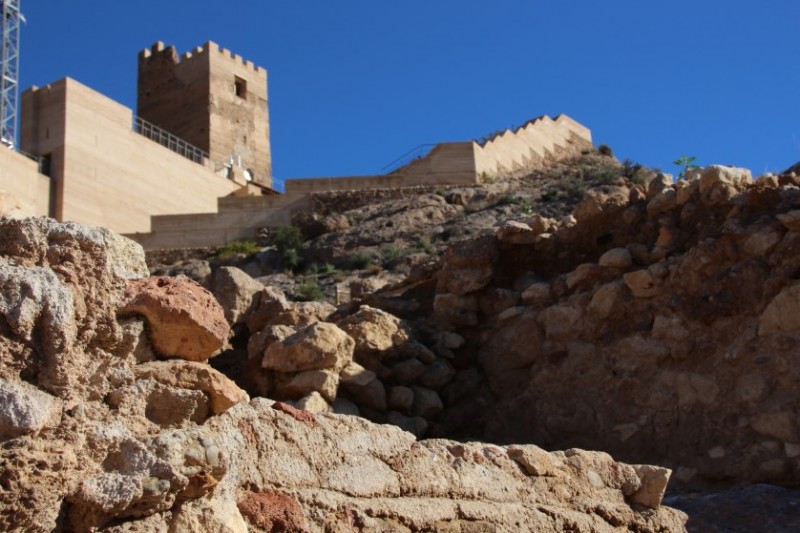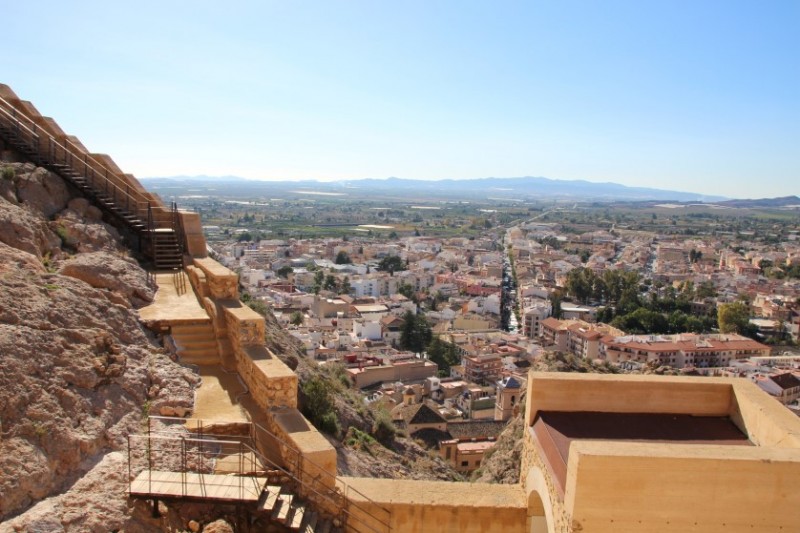The castle of Alhama de Murcia

The fortress of Alhama was built by the Moors and later occupied by Christian feudal lords
During its history the Region of Murcia has been occupied by a series of cultures which define both its character and the people who live here today, and Alhama de Murcia has been home at various points in its history to numerous of the peoples who arrived here.
For a full background history of Alhama de Murcia click here
2,000 years ago it was the Romans who were attracted to Alhama by the mineral deposits and the existence of a thermal spring which enabled them to build a bath complex, but the story of the castle in Alhama begins, as far as we know, with the Moorish rule over southern Spain which began in the early 8th century.
When the north Africans engaged in agriculture on the plain of the Guadalentín valley it is safe to say that they had some system by which to watch over the farmland, but no mention is made of the existence of a fortress or castle until the 11th and 12th centuries, when it is referred to as “Hisn Al-hamma”. This fortress stood on a hill at the foot of the Sierra de la Muela, 285 metres above sea level and just over 100 metres above the level of the plain below, a location which was (and still is!) ideal for watching over travellers as they pass along the Guadalentín valley.
The castle was a part of the defence fortifications of the Moorish “taifa” (or kingdom) of Murcia, reinforcing the frontiers with Granada to the west and Aragón to the north, and similar structures were built in the neighbouring towns of Lorca and Aledo.
Alhama and its castle remained under Moorish rule until the kingdom of Murcia was reconquered by Prince Alfonso of Castile, later Alfonso X “El Sabio”, in 1243, and then became home to one of Alfonso’s knights, Rodrigo de Villamayor, who was awarded governorship of Alhama and the surrounding countryside in recognition of his services.

For a brief spell the castle was under the control of Jaime II of Aragón, who took it by siege at the second attempt in 1298. During the siege he employed catapults, and the damage done (and some of the projectiles fired) can still be seen today, but in 1304 the town and castle of Alhama were returned to Castilian rule. This remained the situation until 1387, when Juan I awarded them to Alonso Yánez Fajardo as a reward for his services in the wars against Portugal and in Granada.
This marked the start of centuries of domination in Alhama by the Fajardo family, who were later awarded the hereditary title of Marquis de los Vélez.
On 6th June 1488 King Fernando II of Aragón (Fernando el Católico) passed through Alhama on the way to Lorca, where he was preparing the campaign which would eventually result in the Reconquest of Granada from the Moors in 1492. Once this was completed there began a long period of relative peace, which allowed the town to grow outside the castle walls.
This growth is reflected by the fact that in 1494 a German traveller named Jerónimo Münzer reports that Alhama consisted of “around 30 houses, a castle, thermal waters and a glass factory”, but by 1530 there were as many as 384 inhabitants.
By the late 16th century the Fajardos had converted the building into a noble home as well as fortress, but within 100 years of that date it had been abandoned, due to military fortifications no longer being deemed necessary after the last Moorish rebellion in 1569-71 and the ensuing expulsion of the last remaining “moriscos”.
It was not until very recently that an effort was made to renovate the castle of Alhama de Murcia: work began in 2010 to restore surviving structures and excavate the remains of others, the aim being to make it possible to open it to the public.
Architecture
As was common in medieval fortresses, the castle is divided into two different spaces, one of them mainly political and military and the other providing protection for the townsfolk and having a more cultural and religious nature.
The higher part at the northern end of the fortification was primarily defensive in nature and is referred to in borrowed Arabic terminology as the “Alcazar”. This is where the “torre del homenaje" (or keep) is located, and in Alhama this consists of a 23-metre tower with an irregular rectangular shape.
The interior has three floors, on top of which was a roof terrace. On the first floor, the inside walls were decorated with stuccos and al fresco paintings, but now only one of the arches of the original ceiling remains. The solid walls of the second floor still remain, but the third has completely disappeared except for the perimeter walls.
Finally there would have been the roof area, with the typical battlements and archers’ emplacements, and troops manning the castle were supplied with water from a deposit which was lined with lime to avoid leaks.
The lower southern end of the castle (or “Albacar”) was home to the local population, and is not as well defended as the higher part: the two areas are united by an exterior circling wall which follows the contours of the hill on the lower side.

The gate into this lower part was well defended in order to prohibit direct entry, and inside there were living quarters, warehouses, stables, etc. Ceramic fragments which have been found here seem to indicate that at some point the area was permanently inhabited, rather than being used only in times of danger to the population, and to the east is the "Balsa de la Reina", a water deposit which supplied those who lived in this communal part of the castle of Alhama.
Outside the castle walls, more Moorish remains have been discovered, including homes on Calle Parricas and Calle Fulgencio Cerón Cava, the cemetery in Calle de la Corredera and the baths in Calle de Sánchez Vidal, and these have helped historians to gain a more complete picture of life in the Moorish settlement of Alhama.
It is also worth mentioning that there are the remains of another building further up the hill, at 330 metres above sea level, on a crest known as the Cerro de las Paleras. This is in a far more dilapidated state than the castle, but ceramics found during archaeological digs here have led to the conclusion that it was probably occupied around the end of the Roman occupation of Spain in the 4th century AD, and perhaps even before the arrival of the Romans, by the Iberians. During the 13th century the area was conquered by Spanish Catholic forces, although the Moors continued to live within the area until their expulsion after revolting against the Christian occupation, some being allowed to stay in the area providing they converted to Christianity.
Visiting the castle of Alhama de Murcia

Unfortunately the restoration work carried out at the castle of Alhama de Murcia is not sufficient for the monument to be open all the time to visitors, but guided tours can be booked through the tourist office. Normally these visits are for groups only (minimum size 20) but exceptions can sometimes be made for smaller parties: prior booking is essential.
These groups are allowed inside the castle, and are given a full tour (in Spanish or English) and explanation of the fortress and the walled area in which protection was afforded to the residents of the town.
The individually booked guided tours are an extension of the regular schedule of such visits operated by the tourist office of Alhama. These take place every other Saturday in Spanish and once a month in English: they last for around 90 minutes, typically starting at 11.00, and participation costs just 3€ for adults and 2€ for children aged 3 to 12.
Alternatively, it is rewarding to simply make your way up from the Plaza Vieja to the outer walls of the fortress. Apart from anything else, this provides great views out over Alhama and the Guadalentín valley – the reason for the castle being located here in the first place - and it is also possible to appreciate the scale of the structure and its dominant location on its promontory at the foot of Sierra Espuña.
Warning: this visit can be a strenuous one for the elderly, and is practically out of the question for those of limited mobility. The walk up the hill is a fairly strenuous one, and access to the castle itself requires the negotiation of tricky metal staircases.
For more local information in English, including news and forthcoming events, visit the home page of Alhama Today.



 Welcome To
Welcome To Alhama de Murcia
Alhama de Murcia


 Welcome To
Welcome To Alhama de Murcia
Alhama de Murcia


 Welcome To
Welcome To Alhama de Murcia
Alhama de Murcia


 Welcome To
Welcome To Alhama de Murcia
Alhama de Murcia

















